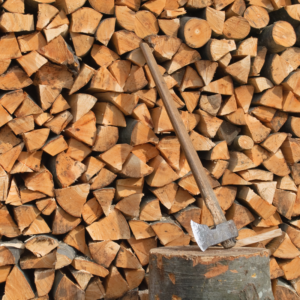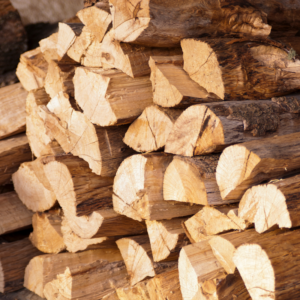Interested in seasoning your own firewood? You’re not alone! Many take this route to ensure they are for sure getting the best pieces available – the ones that offer those hotter, cleaner burns.
That said, seasoning your own firewood isn’t as simple as cutting some logs and stacking them near your home. It’s a process that needs to be approached correctly to guarantee you get those quality results you’re seeking.
How Long Does it Take to Season Wood?
 So, you might be thinking… Why talk about seasoning wood in February when most people don’t even start their burning seasons until September or October? Well, firewood takes about 6 months to properly dry out. Green, fresh wood will have a moisture content of around 40 – 50%, while seasoned wood should have a moisture content of around 15 – 25% – it takes some time to bridge that gap!
So, you might be thinking… Why talk about seasoning wood in February when most people don’t even start their burning seasons until September or October? Well, firewood takes about 6 months to properly dry out. Green, fresh wood will have a moisture content of around 40 – 50%, while seasoned wood should have a moisture content of around 15 – 25% – it takes some time to bridge that gap!
So, if you want it ready at the start of your burning season, now is the time to start the process.
Why Use Seasoned Wood?
Why is using only seasoned wood an important part of building successful fires?
- More water means more energy is wasted. All the water in your firewood needs to be burned through before your flames can really get going, which means lighting it will be harder, and it won’t burn as nicely, either.
- More water means more smoke. Water in the wood leads to more smoke, which can put a big damper on your cozy aesthetic. This can also lead to health issues, especially for infants, the elderly, or those with pre-existing respiratory issues.
- More water means less productive fires. If you use wet wood, your fires will be cooler and they won’t give you that efficient burning you’re striving for.
- More water means more creosote. The more water in your wood, the more condensation you’ll experience, which leads to creosote build-up. This puts you at a higher risk of experiencing chimney fires, and you’ll need to invest in more chimney sweepings over time, too.
In the end, going through the seasoning process to ensure your system is getting the best fuel available is well worth the effort!
Seasoning Your Firewood
So, what’s there to know about seasoning your own firewood?
 First things first, all firewood should be stored off the ground and in a sunny area. Pile the logs on concrete blocks or wood pallets to keep it away from soil and dirt (which attracts moisture). Even gravel can work well to keep moisture at bay!
First things first, all firewood should be stored off the ground and in a sunny area. Pile the logs on concrete blocks or wood pallets to keep it away from soil and dirt (which attracts moisture). Even gravel can work well to keep moisture at bay!
Or, if you have a shed, this could be ideal, too. Sheds for wood storage should have a reliable, sturdy roof to protect the pile from rain and snow, while also having open sides, so that wind, sun, and heat can easily access the logs.
You’ll also want to keep the wood pile away from your home, as these piles tend to attract termites and other pests. Your best bet is to store about a week’s worth by your home at a time. This ensures you have easy access, while avoiding an annoying infestation.
As for cutting and stacking, we recommend following these guidelines:
- Cut the pieces shorter to ensure they fit in your firebox. This also helps them dry out faster!
- Split the ends to expose more surface area to the wind and sun.
- To avoid topples, cut your pieces to the same length, and line up the ends as you stack them. You’ll also want to start with the biggest logs on the bottom.
- Lining things up evenly is important for stability, but you’ll also want to leave some gaps and openings throughout the pile. This allows wind and heat to access the logs in the middle and near the bottom, too.
- Don’t stack higher than 4 feet to minimize the risk of tall piles falling on young kiddos or small pets.
- After 3 – 4 years, it’s time to discard any unused wood. After this long, it simply won’t burn as well as newer logs.
What Not to Burn
So, it’s clear that seasoned wood is the best fuel for fireplace fires (and all you should be using, if you can help it), but what types of wood should you absolutely avoid burning?
- Driftwood: Driftwood has salt in it, and this will cause a dangerous chemical that’s been linked to cancer to release into your air.
- Treated, Painted, or Sealed Wood: All of these release toxic chemicals, some on which are known to cause cancer, and all of which are harmful to your health.
- Fresh or Wet Wood: We’ve been over this, but just remember to avoid burning green wood as much as possible!
- Pine, Fir, or Spruce: When burning these, they produce more sparks, more smoke, and more creosote. These trees are better used for kindling, as putting them in a big fire can invite some serious hazards.
And while we’re on the subject of what not to burn, make sure you’re not tossing things like wrapping paper, cardboard, paper, plastic, construction scraps, Christmas trees, and other types of garbage into your fires! Again, they release harmful fumes that can put you at risk and increase creosote deposits.
Reach Out to Our Crew!
Spring is right around the corner! Spring and summer are the ideal time to invest in chimney repairs, to ensure you’re all set and ready to light fires when fall weather comes back around.
Reach out today with questions or to set up an appointment. We’d love to speak with you soon!
